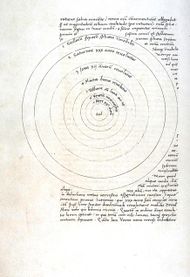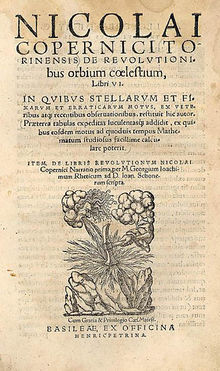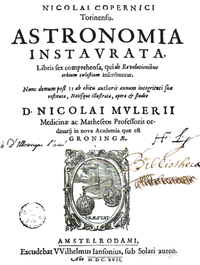De revolutionibus orbium coelestium
| De revolutionibus orbium coelestium | |
|---|---|
|
Original 1543 Nuremberg edition. |
|
| Author | Nicolaus Copernicus |
| Language | Latin |
| Subject(s) | Astronomy |
| Publisher | Johannes Petreius |
| City | Nuremberg |
| Publication date | 1543 |
| Pages | 405 |
De revolutionibus orbium coelestium (On the Revolutions of the Heavenly Spheres) is the seminal work on the heliocentric theory of the Renaissance astronomer Nicolaus Copernicus (1473–1543). The book, first printed in 1543 in Nuremberg, Holy Roman Empire of the German Nation, offered an alternative model of the universe to Ptolemy's geocentric system, which had been widely accepted since ancient times.
Contents |
History

Copernicus initially outlined his system in a short, untitled, anonymous manuscript that he distributed to several friends, referred to as the Commentariolus. A physician's library list dating to 1514 includes a manuscript whose description matches the Commentariolus, so Copernicus must have begun work on his new system by that time.[1] Most historians believe that he wrote the Commentariolus after his return from Italy, possibly only after 1510. At this time, Copernicus anticipated that he could reconcile the motion of the Earth with the perceived motions of the planets easily, with fewer motions than were necessary in the Alfonsine Tables, the version of the Ptolemaic system current at the time.
Observations of Mercury by Bernhard Walther (1430–1504) of Nuremberg, a pupil of Regiomontanus, were made available to Copernicus by Johannes Schöner, 45 observations in total, 14 of them with longitude and latitude. Copernicus used three of them in De revolutionibus, giving only longitudes, and erroneously attributing them to Schöner. Copernicus' values differed slightly from the ones published by Schöner in 1544 in Observationes XXX annorum a I. Regiomontano et B. Walthero Norimbergae habitae, [4°, Norimb. 1544].
Remarkably, a manuscript of De revolutionibus in Copernicus' own hand has survived. After his death, it was given to his pupil, Rheticus, who for publication had only been given a copy without annotations. Via Heidelberg, it ended up in Prague, where it was rediscovered and studied in the 19th century. Close examination of the manuscript, including the different types of paper used, helped scholars construct an approximate timetable for its composition. Apparently Copernicus began by making a few astronomical observations to provide new data to perfect his models. He may have begun writing the book while still engaged in observations. By the 1530s a substantial part of the book was complete, but Copernicus hesitated to publish.
In 1539 Georg Joachim Rheticus, a young mathematician from Wittenberg, arrived in Frauenburg (Frombork) to study with him. Rheticus read Copernicus' manuscript and immediately wrote a non-technical summary of its main theories in the form of an open letter addressed to Johannes Schöner, his astrology teacher in Nürnberg; he published this letter as the Narratio Prima in Danzig in 1540. Rheticus' friend and mentor Achilles Gasser published a second edition of the Narratio in Basel in 1541. Due to its friendly reception, Copernicus finally agreed to publication of more of his main work--in 1542, a treatise on trigonometry, which was taken from the second book of the still unpublished De revolutionibus. Rheticus published it in Copernicus' name.
Under strong pressure from Rheticus, and having seen that the first general reception of his work had not been unfavorable, Copernicus finally agreed to give the book to his close friend, Bishop Tiedemann Giese, to be delivered to Rheticus in Wittenberg for printing by Johannes Petreius at Nürnberg (Nuremberg). It was published just before Coperniucus' death, in 1543.
Contents

Copernicus' magnum opus was the fruit of decades of labor. It rewrote Ptolemaic theory for a moving Earth, and incorporated over a thousand years of accounts of astronomical observations of varying accuracy. In its standard English edition, the book contains 330 folio pages, 100 pages of tables, and over 20,000 tabulated numbers.
The book is dedicated to Pope Paul III in a preface that argues that mathematics, not physics, should be the basis for understanding and accepting his new theory.
De revolutionibus is divided into six "books" (sections or parts):
- Book I is a general vision of the heliocentric theory, and a summarized exposition of his cosmology.
- Book II is mainly theoretical and describes the principles of spherical astronomy and a list of stars, as a basis for the arguments developed in the following books.
- Book III describes the apparent movements of the Sun and related phenomena.
- Book IV is a similar description of the Moon and its orbital movements.
- Books V and VI are the concrete exposition of the new system and explain how to calculate the positions of astronomical objects based on the heliocentric model.
Copernicus argued that the universe comprised eight spheres. The outermost consisted of motionless, fixed stars, with the Sun motionless at the center. The known planets revolved about the Sun, each in its own sphere, in the order: Mercury, Venus, Earth, Mars, Jupiter, Saturn. The Moon, however, revolved in its sphere around the Earth. What appeared to be the daily revolution of the Sun and fixed stars around the Earth was actually the Earth's daily rotation on its own axis.
For philosophical reasons, Copernicus clung to the belief that all the orbits of celestial bodies must be perfect circles[2] and to a belief in the unobserved crystalline spheres. This forced Copernicus to retain the Ptolemaic system's complex system of epicycles, to account for the observed deviations from circularity and to square his calculations with observations.
Despite Copernicus' adherence to these aspects of ancient astronomy, his radical shift from a geocentric to a heliocentric cosmology was a serious blow to Aristotle's science—and helped usher in the Scientific Revolution.
Foreword

De revolutionibus begins with a foreword that defends the work against those who might be offended by its novel hypotheses. It explains that astronomers may find different causes for observed motions and may choose whatever is easier to grasp. As long as a hypothesis allows reliable computation, it does not have to match what a philosopher might seek as the truth.
At the time of publication, those who were not intimately familiar with Copernicus' work assumed that he had written the foreword. Copernicus' friends, on the other hand, were furious, because it diminished Copernicus' bold claims. Rheticus had entrusted Andreas Osiander with supervising the printing and publication, and in fact it had been Lutheran philosopher Osiander who had anonymously written and inserted the infamous foreword. Giese urged the Nuremberg city council to issue a correction, but this was not done, and the matter was forgotten.
Petreius had sent a copy to Hieronymus Schreiber, an astronomer from Nuremberg who died in 1547 but left in his copy of the book a note about Osiander's authorship. Via Michael Mästlin, this copy came to Johannes Kepler, who discovered what Osiander had done[3][4] and methodically demonstrated that Osiander had indeed added the foreword.[5] The most knowledgeable astronomers of the time had realized that the foreword was Osiander's doing. Johannes Praetorius (1537–1616), for example, wrote Osiander's name in the margin of the foreword in his copy of De revolutionibus.
All three early editions of De revolutionibus included Osiander's foreword.
Reception
Even before the 1543 publication of De revolutionibus, rumors circulated about its central theses. Martin Luther is quoted as saying in 1539:
People gave ear to an upstart astrologer who strove to show that the earth revolves, not the heavens or the firmament, the sun and the moon.... This fool wishes to reverse the entire science of astronomy; but sacred Scripture tells us [Joshua 10:13] that Joshua commanded the sun to stand still, and not the earth.[6]
When the book was finally published, demand was low, with an initial print run of 400 failing to sell out.[7] Copernicus had made the book extremely technical, unreadable to all but the most advanced astronomers of the day, allowing it to disseminate into their ranks before stirring great controversy.[8] And, like Osiander, contemporary mathematicians and astronomers encouraged its audience to view it as a useful mathematical fiction with no physical reality, thereby somewhat shielding it from accusations of blasphemy.[9]
Very soon, nevertheless, Copernicus' theory was attacked with Scripture and with the common Aristotelian proofs. In 1549 Melanchthon, Luther's principal lieutenant, wrote against Copernicus, pointing to the theory's apparent conflict with Scripture and advocating that "severe measures" be taken to restrain the impiety of Copernicans.[10] The works of Copernicus and Zúñiga—the latter for asserting that De revolutionibus was compatible with Catholic faith—were placed on the Index of Forbidden Books by a decree of the Sacred Congregation of March 5, 1616:
This Holy Congregation has also learned about the spreading and acceptance by many of the false Pythagorean doctrine, altogether contrary to the Holy Scripture, that the earth moves and the sun is motionless, which is also taught by Nicholaus Copernicus' De revolutionibus orbium coelestium and by Diego de Zúñiga's In Job.... Therefore, in order that this opinion may not creep any further to the prejudice of Catholic truth, the Congregation has decided that the books by Nicolaus Copernicus [De revolutionibus] and Diego de Zúñiga [In Job] be suspended until corrected.[11]
De revolutionibus was not formally banned but merely withdrawn from circulation, pending "corrections" that would clarify the theory's status as hypothesis. Nine sentences that represented the heliocentric system as certain were to be omitted or changed. After these corrections were prepared and formally approved in 1620 the reading of the book was permitted.[12] But the book was never reprinted with the changes and was available in Catholic jurisdictions only to suitably qualified scholars, by special request. It remained on the Index until 1758, when Pope Benedict XIV (1740-58) removed the uncorrected book from his revised Index.[13]
A few years after Copernicus' death, Erasmus Reinhold developed the Prutenic Tables ("Prussian Tables"; Latin: Tabulae prutenicae; German: Preußische Tafeln) using Copernicus' methods. The Prutenic Tables, published in 1551, were used as a basis for the calendar reform instituted in 1582 by Pope Gregory XIII. They were also used by sailors and maritime explorers, whose 15th-century predecessors had used Regiomontanus' Table of the Stars.
Lactantius
In the preface[14] to De revolutionibus, Nicolaus Copernicus mocked Lactantius, an early Christian author (ca. 240 – ca. 320):
Perhaps there will be babblers who claim to be judges of astronomy although completely ignorant of the subject and, badly distorting some passage of Scripture to their purpose, will dare to find fault with my undertaking and censure it. I disregard them even to the extent of despising their criticism as unfounded. For it is not unknown that Lactantius, otherwise an illustrious writer but hardly an astronomer, speaks quite childishly about the earth's shape, when he mocks those who declared that the earth has the form of a globe. Hence scholars need not be surprised if any such persons will likewise ridicule me. Astronomy is written for astronomers.[15]
A German TV documentary on "The seven greatest lies in history" [16] states that medieval scholars knew full well that the Earth was a sphere. Copernicus is blamed for having omitted to say that Lactantius had been the exception rather than the rule, and thus for having contributed to the flat-Earth myth.
Gingerich
Historians long believed that, at its first publication, De revolutionibus had not been widely read. Owen Gingerich, a widely recognized authority on both Nicolaus Copernicus and Johannes Kepler, disproved this after a 35-year project to examine every surviving copy of the first two editions. Gingerich showed that nearly all the leading mathematicians and astronomers of the time owned and read the book; however, his analysis of the marginalia shows that they almost all ignored the cosmology at the beginning of the book and were only interested in Copernicus' new equant-free models of planetary motion in the later chapters. Also, Nicolaus Reimers in 1587 translated the book into German.
Gingerich's efforts and conclusions are recounted in The Book Nobody Read, published in 2004 by Walker & Co. The research behind this book earned its author the Polish government's Order of Merit in 1981. Due largely to Gingerich's scholarship, De revolutionibus has been researched and catalogued better than any other first-edition historic text except for the original Gutenberg Bible.[17]
Editions
- 1543, Nuremberg, by Johannes Petreius
- 1566, Basel, by Henricus Petrus
- 1617, Amsterdam, by Nicolaus Mulerius
- 1854, Warsaw, with Polish translation and the authentic preface by Copernicus.
- 1873, Thorn, German translation sponsored by the local Coppernicus Society, with all Copernicus' textual corrections given as footnotes.
Translations
English translations of De revolutionibus have included:
- On the Revolutions of the Heavenly Spheres, translated with an introduction and notes by A.M. Duncan, Newton Abbot, David & Charles, ISBN 0-7153-6927-X; New York, Barnes and Noble, 1976, ISBN 0-06-491279-5.
- On the Revolutions; translation and commentary by Edward Rosen, Baltimore, Johns Hopkins University Press, 1992, ISBN 0-8018-4515-7. (Foundations of Natural History. Originally published in Warsaw, Poland, 1978.)
- On the Revolutions of the Heavenly Spheres, translated by C.G. Wallis, Annapolis, St John's College Bookstore, 1939. Republished in volume 16 of the Great Books of the Western World, Chicago, Encyclopædia Britannica, 1952; in the series of the same name, published by the Franklin Library, Franklin Center, Philadelphia, 1985; in volume 15 of the second edition of the Great Books, Encyclopædia Britannica, 1990; and Amherst, N.Y., Prometheus Books, 1995, Great Minds Series—Science, ISBN 1-57392-035-5.
Notes
- ↑ Gingerich, 2004, p. 32
- ↑ Gingerich, 2004, p. 23
- ↑ Edward Rosen: Three Copernican Treatises: The Commentariolus of Copernicus, The Letter Against Werner, The Narratio Prima of Rheticus, Courier Dover Publications, 2004, ISBN 0486436055, p. 24.
- ↑ Koestler, 1959, p. 169
- ↑ Robert Westman, "Three Responses to Copernican Theory," in Robert Westman, ed., The Copernican Achievement, 1975.
- ↑ Quoted in Thomas Kuhn, The Copernican Revolution, Cambridge, Massachusetts, Harvard University Press, 1957, p. 191.
- ↑ Philip Ball, The Devil's Doctor: Paracelsus and the World of Renaissance Magic and Science, ISBN 978-0-09-945787-9, p. 354.
- ↑ Thomas Kuhn, The Copernican Revolution, p. 185.
- ↑ Thomas Kuhn, The Copernican Revolution, pp. 186–87.
- ↑ Thomas Kuhn, The Copernican Revolution, p. 192. Kuhn writes that Melanchthon emphasized Ecclesiastes 1:4-5 ("The earth abideth forever ... the sun also ariseth, and the sun goeth down, and hasteth to his place where he arose").
- ↑ Original Latin text and an English translation. Also mentioned by W. R. Shea and M. Artigas in Galileo in Rome (2003), p. 84-85, ISBN 0-19-516598-5.
- ↑ "Nicolaus Copernicus", Catholic Encyclopedia.
- ↑ "Benedict XIV", Catholic Encyclopedia.
- ↑ http://la.wikisource.org/wiki/Pagina:Nicolai_Copernici_torinensis_De_revolutionibus_orbium_coelestium.djvu/8
- ↑ On the Revolutions, translation and commentary by Edward Rosen, Johns Hopkins Paperbacks Ed., 1992, p. 5, lines 37-45.
- ↑ ZDF Die sieben größten Lügen der Geschichte
- ↑ Peter DeMarco. "Book quest took him around the globe". Boston Globe. April 13, 2004
References
- Gassendi, Pierre: The Life of Copernicus, biography (1654), with notes by Olivier Thill (2002), ISBN 1-59160-193-2 [1] [2]
- Gingerich, Owen: An annotated census of Copernicus' De revolutionibus (Nuremberg, 1543 and Basel, 1566). Leiden : Brill, 2002 ISBN 90-04-11466-1 (Studia copernicana. Brill's series; v. 2)
- Gingerich, Owen (2004). The Book Nobody Read : Chasing the Revolutions of Nicolaus Copernicus. New York : Walker. ISBN 0-8027-1415-3.
- Hannam, James (2007). "Deconstructing Copernicus". Medieval Science and Philosophy. http://jameshannam.com/copernicus.htm. Retrieved 2007-08-17. Analyses the varieties of argument used by Copernicus.
- Heilbron, J.L.: The Sun in the Church: Cathedrals as Solar Observatories. Cambridge, Massachusetts, Harvard University Press, 1999 ISBN 0-674-85433-0
- Koestler, Arthur (1959). The Sleepwalkers. Hutchison.
- Swerdlow, N.M., O. Neugebauer: Mathematical astronomy in Copernicus' De revolutionibus. New York : Springer, 1984 ISBN 0-387-90939-7 (Studies in the history of mathematics and physical sciences ; 10)
- Vermij, R.H.: The Calvinist Copernicans: The Reception of the New Astronomy in the Dutch Republic, 1575-1750. Amsterdam : Koninklijke Nederlandse Akademie van Wetenschappen, 2002 ISBN 90-6984-340-4 [3]
- Westman, R.S., ed.: The Copernican achievement. Berkeley : University of California Press, 1975 ISBN 0-520-02877-5
- Zinner, E.: Entstehung und Ausbreitung der coppernicanischen Lehre. 2. Aufl. durchgesehen und erg. von Heribert M. Nobis und Felix Schmeidler. München : C.H. Beck, 1988 ISBN 3-406-32049-X
External links
- De revolutionibus orbium coelestium, from Harvard University.
- De revolutionibus orbium coelestium, from Jagiellon University, Poland.
- De Revolutionibus Orbium Coelestium, from Rare Book Room.
- On the Revolutions, from WebExhibits. English translation.
- River Campus Libraries, Book of the Month December 2005: De revolutionibus orbium coelestium